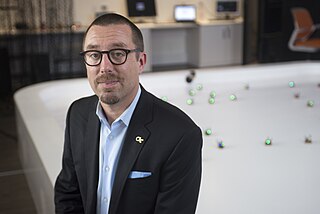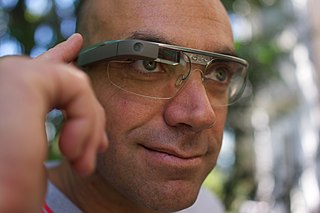
A wearable computer, also known as a wearable or body-borne computer, is a computing device worn on the body. The definition of 'wearable computer' may be narrow or broad, extending to smartphones or even ordinary wristwatches.

ATI Technologies Inc. was a Canadian semiconductor technology corporation based in Markham, Ontario, that specialized in the development of graphics processing units and chipsets. Founded in 1985 as Array Technology Inc., the company listed publicly in 1993. Advanced Micro Devices (AMD) acquired ATI in 2006. As a major fabrication-less or fabless semiconductor company, ATI conducted research and development in-house and outsourced the manufacturing and assembly of its products. With the decline and eventual bankruptcy of 3dfx in 2000, ATI and its chief rival Nvidia emerged as the two dominant players in the graphics processors industry, eventually forcing other manufacturers into niche roles.

Texas Tech University is a public research university in Lubbock, Texas. Established on February 10, 1923, and called Texas Technological College until 1969, it is the main institution of the five-institution Texas Tech University System. The university's student enrollment is the seventh-largest in Texas as of the Fall 2018 semester. As of fall 2020, there were 40,322 students enrolled at Texas Tech. With over 25% of its undergraduate student population identifying as Hispanic, Texas Tech University is a designated Hispanic-serving institution (HSI).

Jones AT&T Stadium at Cody Campbell Field, previously known as Clifford B. and Audrey Jones Stadium, Jones SBC Stadium and Jones AT&T Stadium, is an outdoor athletic stadium on the campus of Texas Tech University in Lubbock, Texas, United States, built in the style of Spanish Renaissance architecture. It is the home field of the Texas Tech Red Raiders football team of the Big 12 Conference.
South by Southwest, abbreviated as SXSW and colloquially referred to as South By, is an annual conglomeration of parallel film, interactive media, and music festivals and conferences organized jointly that take place in mid-March in Austin, Texas, United States. It began in 1987 and has continued to grow in both scope and size every year. In 2017, the conference lasted for 10 days with the interactive track lasting for five days, music for seven days, and film for nine days.

Magnus B. Egerstedt is a Swedish-American roboticist who is the Dean of the Henry Samueli School of Engineering at the University of California, Irvine. He was formerly the Steve C. Chaddick School Chair and Professor at the School of Electrical and Computer Engineering, Georgia Institute of Technology.

Silicon Hills is a nickname for the cluster of high-tech companies in the Austin metropolitan area in the U.S. state of Texas. Silicon Hills has been a nickname for Austin since the mid-1990s. The name is analogous to Silicon Valley, but refers to the hilly terrain on the west side of Austin. High tech industries in the area include enterprise software, semiconductors, corporate R&D, biotechnology, the video game industry, and a variety of startup companies.

East London Tech City is the term for a technology cluster of high-tech companies located in East London, England. Its main area lies broadly between St Luke's and Hackney Road, with an accelerator space for spinout companies at the Queen Elizabeth Olympic Park.

Guide was a US technology startup company developing a newsreader app that translates text from online news sources, blogs and social media streams into streaming audio and video. The company's apps include animal character readers. The company was founded in 2012 by chief executive officer Freddie Laker, and privately launched its mobile app in alpha in February 2013.
Freddie Allen Laker is a British-American entrepreneur and the founder of the tech startup Guide. Prior to founding Guide, he launched the Internet service provider Laker.net and the digital agency iChameleon Group, and worked at SapientNitro as the company's vice president of global marketing strategy. He is the son of Freddie Laker, the founder of British airline Laker Airways.
Desti is a travel guide app and a spin-off of SRI International that uses SRI's CALO artificial intelligence technology to help users plan trips. The app went to public beta in November 2012.

An optical head-mounted display (OHMD) is a wearable device that has the capability of reflecting projected images as well as allowing the user to see through it, similar to augmented reality technology. OHMD technology has existed since 1997 in various forms, but despite a number of attempts from industry, has yet to be commercialised.
CrowdOptic, Inc. is a privately held San Francisco-based medical technology company founded in 2011. CrowdOptic, led by CEO Jon Fisher, is best known for its augmented reality technology and triangulation algorithms used in medicine, sports, and government that gathers and analyzes data from smart devices based on where they are pointed to identify areas of interest. As of 2016, CrowdOptic remains the only patented solution for wearables like Google Glass and Sony SmartEyeGlass.

Umoove is a high tech startup company that has developed and patented a software-only face and eye tracking technology. The idea was first conceived as an attempt to aid people with disabilities but has since evolved. The only compatibility qualification for tablet computers and smartphones to run Umoove software is a front-facing camera. Umoove headquarters are in Israel on Jerusalem’s Har Hotzvim.
Pointman is a seated user interface for controlling one's avatar in a 3D virtual environment. It combines head tracking, a gamepad, and sliding foot pedals to provide positional control over many aspects of the avatar's posture. Pointman was developed by the US Naval Research Laboratory (NRL) to support the use of dismounted infantry simulation for USMC training and mission rehearsal. NRL's goal in developing Pointman was to extend the range and precision of actions supported by virtual simulators, to better represent what infantrymen can do.

Tango was an augmented reality computing platform, developed and authored by the Advanced Technology and Projects (ATAP), a skunkworks division of Google. It used computer vision to enable mobile devices, such as smartphones and tablets, to detect their position relative to the world around them without using GPS or other external signals. This allowed application developers to create user experiences that include indoor navigation, 3D mapping, physical space measurement, environmental recognition, augmented reality, and windows into a virtual world.

Smartglasses or smart glasses are wearable computer glasses that add information alongside or to what the wearer sees. Alternatively, smartglasses are sometimes defined as wearable computer glasses that are able to change their optical properties at runtime. Smart sunglasses which are programmed to change tint by electronic means are an example of the latter type of smartglasses.
TubeMogul is an enterprise software company for brand advertising.
Oswald Labs is a Dutch-Indian based accessibility technology company that builds products for individuals with disabilities. It specializes in enterprise web accessibility, offers smartphone apps, and also runs a startup accelerator. It was established in 2016 by Anand Chowdhary, Nishant Gadihoke and Mahendra Raghuwanshi after their product, Oswald Extension, won an event at the AngelHack hackathon in New Delhi.

Lego Life of George was a Lego theme that for the first time, combined standard Lego bricks with a mobile app. The theme was first introduced in October 2011. It was eventually discontinued by the end of December 2013.










